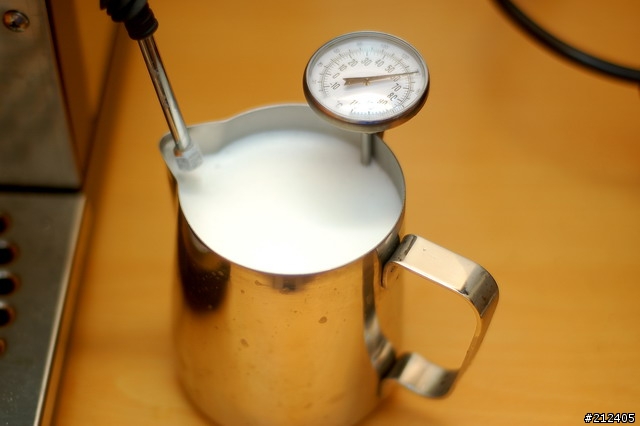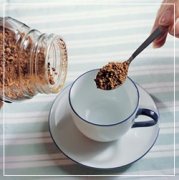The Encyclopedia of Fine Coffee explains the meaning of latte in detail

The chemical composition of milk is protein, lipid, carbohydrate, inorganic, phospholipid, trace vitamins and so on. The formation of milk bubbles is due to the formation of a thin film on the surface when the milk is heated to more than 40 ℃. Just like we go to the convenience store to buy a bottle of fresh milk and heat it in the microwave, there will be a thin layer of fresh milk on the surface.
That is because the skin membrane formed by heating and solidification of milk protein floats on the surface. By the way, I would like to correct the concept that has been misunderstood by partners for a long time. The main reason for the formation of milk bubbles is not milk fat. If you think about it, if the formation of milk bubbles is milk fat, the foam of low-fat milk (milk fat less than 2%) should not be played quite well, but in fact, low-fat milk still produces dense foam. The reason is simple: low-fat milk still retains the milk protein that forms bubbles. So whether you can make milk foam or not has nothing to do with milk fat.
Going back to the topic just now, when the partner is steaming milk, the steam sent by the steam rod head has an instantaneous temperature of more than 40 ℃, which is enough to heat the milk protein to form a film, and the film covers the air in the steam cyclone, forming the milk bubbles that get along with us day and night, and make the milk more fragrant!
However, if the milk is heated for more than 75 ℃, or for a long time, the protein structure that previously solidified into the foam begins to disintegrate, so the foam begins to thicken and become ugly, just like soap bubbles.
Therefore, when cooking milk into "mistress" (milk that has been steamed once and cooled and reused), because the previous protein has been solidified and combined in the first cooking, so there is no unsolidified protein in the second milk, so heating with steam is just breaking up the chain of previously solidified proteins and making the milk drink thinner. This is why "extra hot" and "mistress" (milk that has been steamed once and cooled and reused) have a smoother taste and the foam is dry and ugly.
I hope you will understand that after the chemical changes in the heating of milk, you can make a gloomy foam and use "one milk" (fresh milk that has not yet been steamed)!
Postscript: milk foam v.s milk fat?
The formation of milk foam is not milk fat, many people have this misunderstanding. If the formation of milk bubbles is milk fat, it is reasonable to say that the foam of low-fat milk (less than 0.2% of milk fat) should not play quite well, but in fact, low-fat milk still produces dense bubbles. The reason is simple: low-fat milk still retains the milk protein that forms bubbles. So whether you can make milk foam or not has nothing to do with milk fat.
Important Notice :
前街咖啡 FrontStreet Coffee has moved to new addredd:
FrontStreet Coffee Address: 315,Donghua East Road,GuangZhou
Tel:020 38364473
- Prev

Common problems and Countermeasures of making Coffee by pressing the Pot
Is "French filter press" the same thing as "French pressure"? Right. The English name is French Press. "French pressure" is a simple and vivid translation, and it has also been translated as "French filter pot" or "French filter pot". What's the difference between "French pressure" and tea maker? The tea maker filter is used to filter the tea, and the mesh is relatively large. French pressure specially used for coffee conditioning, because
- Next

Encyclopedia of Coffee talking about the positive solution of instant coffee
The decline and growth of coffee around the world has also led to a multi-dimensional development of coffee, and the deepest impact is the problem of instant coffee (Instant Coffee Powder Powder). Instant coffee has the characteristics of easy to use, breaking the usual bundles of brewing coffee, and quickly integrated into the food industry. The use of instant coffee in China
Related
- Beginners will see the "Coffee pull flower" guide!
- What is the difference between ice blog purified milk and ordinary milk coffee?
- Why is the Philippines the largest producer of crops in Liberia?
- For coffee extraction, should the fine powder be retained?
- How does extracted espresso fill pressed powder? How much strength does it take to press the powder?
- How to make jasmine cold extract coffee? Is the jasmine + latte good?
- Will this little toy really make the coffee taste better? How does Lily Drip affect coffee extraction?
- Will the action of slapping the filter cup also affect coffee extraction?
- What's the difference between powder-to-water ratio and powder-to-liquid ratio?
- What is the Ethiopian local species? What does it have to do with Heirloom native species?

